Everyone has a cherished movie theater experience they remember to this day. For me, it was watching La La Land with my sister. She isn’t the biggest fan of jazz, so I enjoyed watching a movie that indulged my passions … while bothering her at the same time!
For many people, recreating those experiences at home is a legitimate pastime. With the right equipment and room setup, you can create a theater in the comfort of your own home.
Today, we’ll look at several speakers from Sonos and Bose – two of the most reputable companies in audio equipment today. While both are excellent, each approach their equipment with unique philosophies.
We’ll look at various types of speakers, and the differences between both companies’ products.
I will assume you have a working knowledge of home theater speakers, but will give brief explanations for beginners as well. With that said, let’s get started!
Table of Contents
The Budget Method: Soundbars and Subwoofers
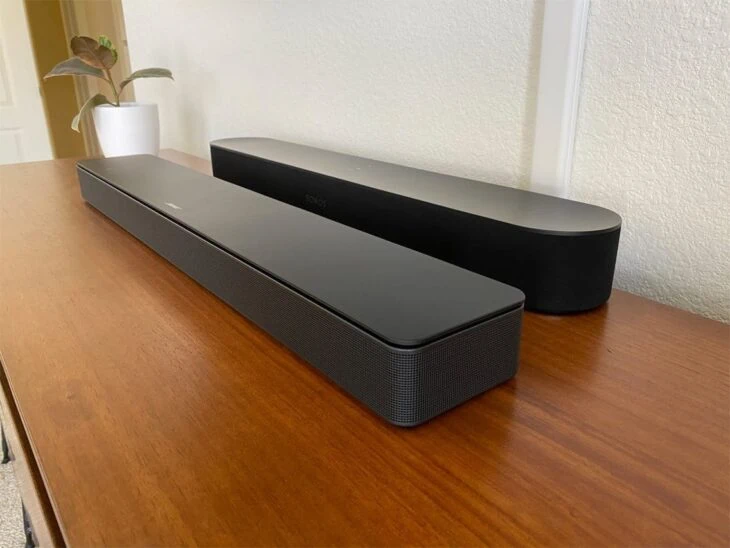
For most of us, we can’t afford a super-expensive setup right away, which is fine! While a budget setup won’t have all the bells and whistles of a high-end one, it will still be excellent if you take the time to think about what you want.
Real theaters use a surround sound setup, meaning they have multiple speakers playing different frequencies all around your seat – so the sound literally surrounds you. While certainly possible at home, surround sound costs more money, simply because more speakers equal more money!
Soundbars, on the other hand, include multiple speakers in a single piece of hardware. This makes them a great budget option.
Since they sit directly in front of your TV, they can’t surround you. But with clever hardware and audio tinkering, they can be effective substitutes.
Sonos’ Philosophy and Soundbars
Sonos is the newer of the two companies and was founded in response to the emerging Wi-Fi technology of the early 2000s. Their goal has always been to deliver excellent sound quality with simple, wireless setups.
However, this comes with a unique philosophy. Most wireless speakers, including Bose, use Bluetooth. Sonos does NOT! Instead, their speakers are connected directly to your home Wi-Fi network.
This isn’t super common, and begs the question, “Why?” While it might seem odd, it certainly has its perks.
First of all, your Sonos speaker becomes seamlessly integrated into your entire network. This means you can play from any device, anywhere in the house (as long as the Wi-Fi signal is within reach).
You still have to “tell” your device where to send its audio, but it’s faster and more streamlined than connecting to Bluetooth. Just like your router, Sonos speakers are always on and simply wait for audio input.
It’s as simple as connecting to your internet. Unlike Bluetooth, you don’t have to stand by the speakers, tell them to connect, and wait for the confirmation beep.
Sonos also has wired options though, if you decide you want wires after all. However, the specs differ between models. This is admittedly confusing, so make sure you double check before any purchases!
Besides wired/wireless features, Sonos also values easy setups and helpful customer service.
Connecting to Wi-Fi might be confusing if you’re used to Bluetooth, but they go to great lengths to make their instructions simple and understandable. Their app allows you to customize the speakers themselves from any device, anywhere in the house.
As far as their products are concerned, they have three “levels” of soundbars.
Sonos Ray
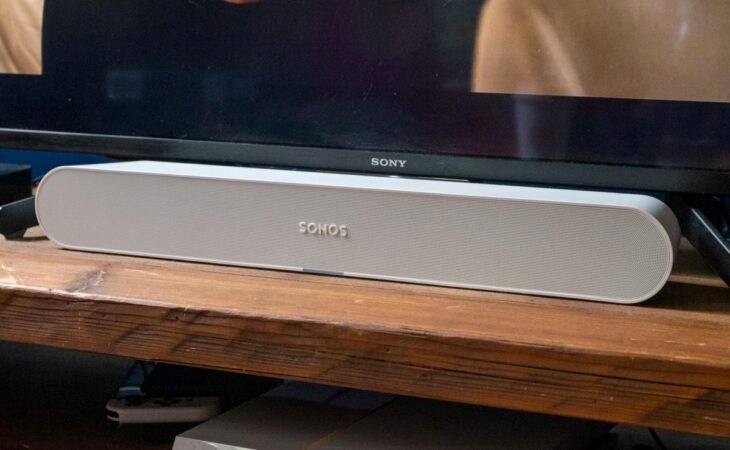
Starting around $300, the Sonos Ray soundbar is an excellent budget choice for users with small rooms. At a moderately cheap price, it delivers crisp dialogue and well-balanced frequencies across the spectrum.
It easily outranks an average speaker, delivering quality sound without being too loud or overwhelming.
It also includes Dolby Atmos technology. This means it treats audio three-dimensionally, even if its internal speakers are set up in a 2D line. While a soundbar won’t deliver real surround-sound, Dolby technology will still make it sound believable.
However, in comparison with other soundbars listed here, the Sonos Ray is definitely the most basic. Wired connections include infrared, optical, and ethernet connections, but NOT HDMI.
I find the ethernet connectivity clever, as it can lead to faster communication between devices and speakers. However, the lack of HDMI connectivity could be a turn-off for many.
If you’re looking for an easy, budget option, the Sonos Ray is a solid choice. Should you choose to augment your setup later, you can add other speakers alongside it.
However, if you’re looking for more features in a single product, you would be better off with the Sonos Beam or Arc.
Sonos Beam
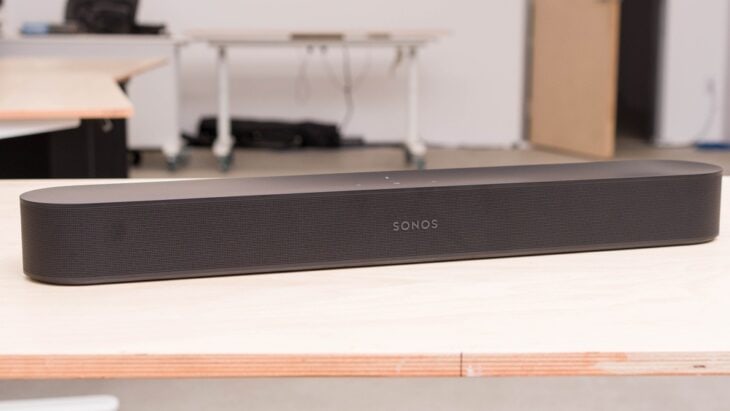
The Sonos Beam is an obvious upgrade from the Sonos Ray, but comes with a higher price. For many users, this price will be worth it.
First off, it includes HDMI eARC connectivity. Besides the inclusion of HDMI itself, the eARC technology improves speed and bandwidth. Second, it supports voice assistants like Alexa and Google Assistant.
Lastly, the built-in processor is optimized for fast processing, meaning less glitches and headaches down the road.
While simple to list, these features are fantastic upgrades.
The one downside worth considering is the Beam’s bass-end. It delivers excellent clarity and quality, but is lacking in the bass. While you might be perfectly happy with the Beam, consider buying a subwoofer to pair with it.
Sonos Arc
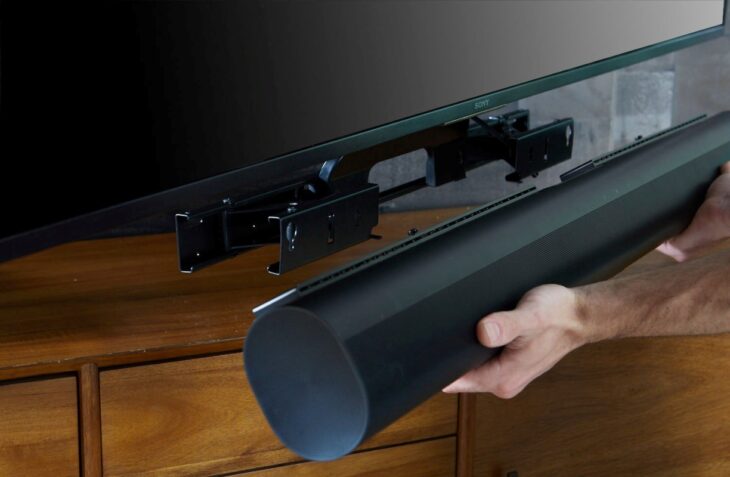
The Sonos Arc is one of Sonos’ most iconic products. Nearing the $1000 mark, it’s definitely a purchase you’ll have to think about. However, if you value quality sound, it’s an investment of work making.
At 45 inches, the Arc definitely takes up more room than the other two. With 11 built-in speakers, optimized for various frequencies, it does a remarkable job at playing every frequency and spreading them everywhere.
Three of its internal speakers are “tweeters,” which emit the highest frequencies straight up towards the ceiling. The remaining 8 are “mid-woofs,” spreading the mid and low frequencies evenly towards your seat.
Paired with the internal power to push each sound to the walls and back, these 11 speakers can make the Arc indistinguishable from true surround-sound setups.
With 11 speakers, the Sonos Arc is easily one of the most expansive soundbars on the market.
Bose Soundbars
While the quality of Sonos is stellar, there are some great features in Bose soundbars that make them serious contenders. Most important on this list, they have Bluetooth and identical connection ports across models.
Bose actually gives you three choices of soundbars; two large ones and one small one. While the soundbars for large rooms produce better audio, the budget ones also perform fantastically.
Bose’s Smart Soundbar 600 and Smart Soundbar 900 are the larger two. Both are extremely similar. Both include voice assistant abilities, Dolby, and EQ adjustment. Oddly, however, the EQ only allows adjustment of bass and treble – nothing in between.
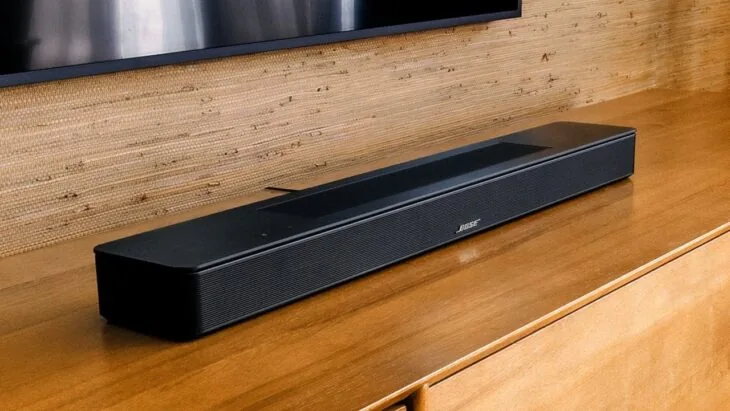
In terms of connectivity, they include both Wi-Fi AND Bluetooth. They also have HDMI eARC.
From my experience listening to Bose’s and Sonos’ soundbars, I find that Bose’s Smart Soundbars have more bass than Sonos’. While not necessarily a dealbreaker (you can supplement a Sonos soundbar with a subwoofer), this can make a considerable difference if you’re on a budget.
While they have almost identical features, the 900 is the only model with ADAPTiQ, a tool that allows you to tinker with the audio output so it matches your room space perfectly. Honestly, though, I think most customers will be content with the 600. I would reserve the 900 for die-hard audiophiles.
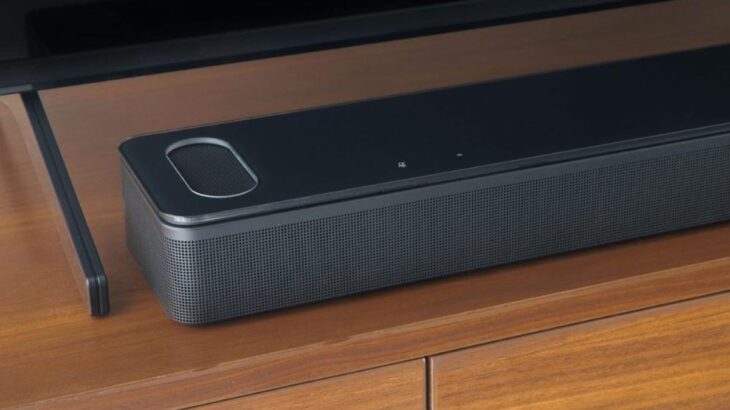
If you can’t afford either model, don’t worry! The Bose Soundbar Solo is an excellent budget alternative for small rooms. With three built-in speakers that are designed to strategically spread sound, it does an exceptional job at mimicking a surround-sound experience with moderate hardware.
Pairing Soundbars With Subwoofers
Soundbars are an excellent budget choice for creating an immersive sound experience with a single piece of equipment. However, they won’t be able to deliver the full spectrum of bass sounds – which are crucial to action movies and bass-heavy music.
Sonos and Bose have a smaller selection of subwoofers than their other products, which actually makes deliberation much easier!
Sonos Subwoofers
Sonos has two subwoofer models: the Sonos Sub and Sonos Sub Mini. As evident by their names, they are extremely similar in every way, except for size.
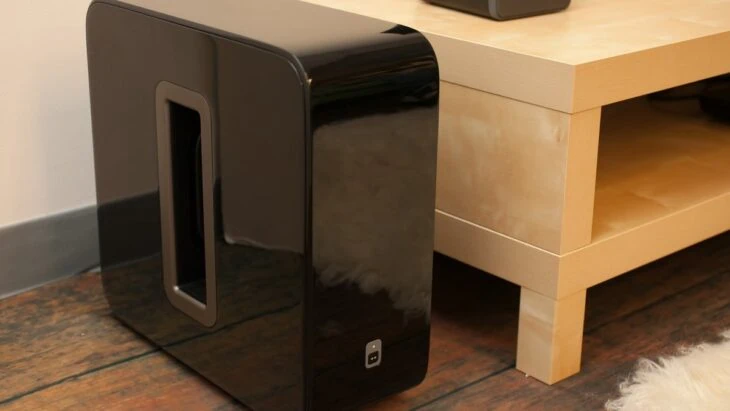
If you want a full-fledged subwoofer with all the perks of a Sonos product, the Sonos Sub is the obvious choice. It produces absolutely no buzzes, and can even rumble your room if you want (or not, if you’d rather not!)
In fact, of all the subwoofers listed here, it can deliver the lowest frequencies of them all (at the expense of a few of the high ones). Paired with a Sonos soundbar, especially the Arc, it delivers an unrivaled experience.
However, it’s worth noting the size of the Sub: it’s 16 inches by 16 inches, and weighs around 36 pounds! This size is essential for producing a full range of bass frequencies but may be a bit big for some rooms.
Another drawback to the Sub is its price. If you’re looking for a cheaper product with a similar experience, the Sonos Sub Mini fits the bill.
It replicates as much of the experience as possible while shrinking down to 9 inches by 12, and 14 pounds. While it won’t be as immersive, for nearly half the price, it’s a no-brainer alternative.
Both models include ethernet ports and work with both 2.4Ghz and 5Ghz routers signals. They also include an NFC pairing button, which makes the Wi-Fi configuration a breeze – even for computer haters!
Lastly, they also let you calibrate the overall bass EQ. Unfortunately, this is only possible with iOS devices. However, if you can get a friend with an iPhone to connect temporarily, you can still tune them up!
Bose Subwoofers
Bose also has two subwoofer models, with the same advantages as their soundbars; namely, you can connect to both Wi-Fi and Bluetooth. The Bose Bass Module 700 is the larger one, while the Bose Bass Module 500 is the smaller one.
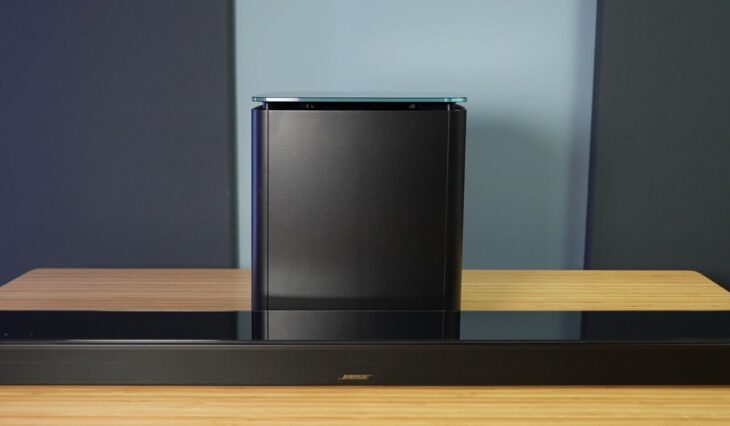
Keeping in theme, the 700 is the better one and the 500 is the budget one. They both produce great, bass-rich sound, but the 700 offers more features. However, some users have reported a slight buzz in the 500 from higher frequencies.
There is a subtle difference between the sounds of Bose subwoofers versus Sonos ones, though it’s only a matter of preference. Bose tends to even out the bass frequencies equally, while Sonos favors the lowest ones.
Both models are smaller than the Sonos Sub and are nearly the same size themselves. The 700 is 11.6 by 11.6 inches, while the 500 is 10 by 10 inches. Paired with their simple square box shape, this makes them super easy to fit in any space.
As with many tech products, the details are important (and unfortunately, confusing sometimes!) If you want a wired connection for either model, you’ll need an auxiliary cord. Despite several reviews mentioning HDMI connectivity, I didn’t see any.
Lastly, the 700 includes quiet port technology, which “reads the room” to customize audio output, with the intention of minimizing distortion and buzzing. It also includes Dolby, while the 500 doesn’t.
If you don’t absolutely want the perks of quiet port and Dolby, you’ll be fine with the 500. However, I would choose the Sonos Sub Mini over the Bose Bass Module 500, given the risk of distortion. It costs slightly more, but I personally believe it’s worth biting the bullet.
The DIY Method: Upgrading Your Soundbar and Subwoofer with Surround Speakers
Do-It-Yourself projects take a lot of work. Like, a LOT of work! But any DIY enthusiast knows that all the effort is well worth it because you get to customize every aspect of your final product.
Maybe you already have a soundbar and/or subwoofer and want to make your setup truly surround sound. Or maybe you’re just really picky about the products you buy and want your setup to fit an exact idea you have in your head.
Either way, it’s rewarding. Plus, this method is the closest you can get to a real movie theater.
In a real movie theater, you have three different kinds of speakers. First, you have four surround-sound speakers that literally surround you; two in front of you on the left and right, and two behind you on the left and right.
Second, you have a central speaker, which focuses on delivering clear, crisp dialogue. Lastly, you have the subwoofer, which fills out the bass frequencies and completes the “aural picture.”
A soundbar is technically two front speakers and a central speaker, packed in a single product. And if you have a subwoofer, you’ve already got your bass (duh…)
What you’re missing, then, is two rear surround speakers! Fortunately for you, both Bose and Sonos make it easy to know what to buy.
Bose Surround Speakers
Bose sells two surround-sound speaker models, the Bose Surround Speakers and Surround Speakers 700. The latter are about $200 more expensive.
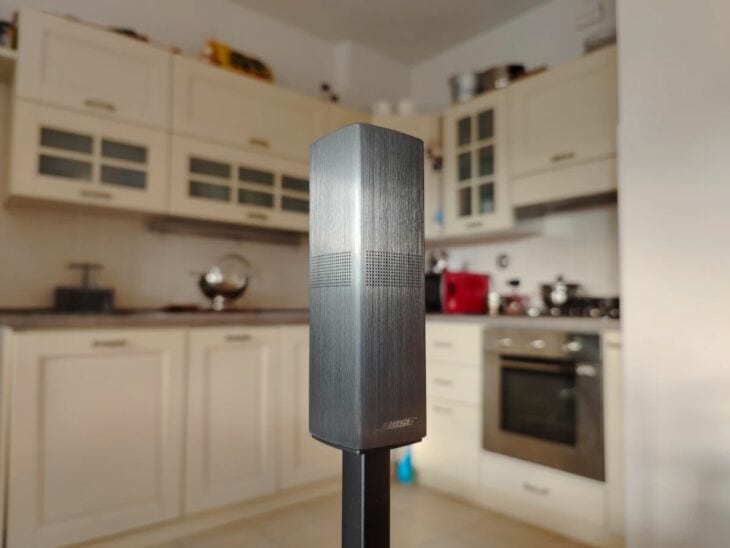
The only difference? The 700s are taller and emit sound in every direction. While this can be great for music, it doesn’t make much of a difference as rear speakers.
I mean, if they’re behind you, they only need to send the sound in your direction. Unless you’re using your speakers for music too, the cheaper option is the obvious choice!
Here’s a quick note though: both types of Bose surround speakers need to be connected to a Bose soundbar, meaning you need to already have a soundbar. Secondly, they can only connect wirelessly.
Sonos Surround-Sound Speakers
Sonos provides two speaker models for surround sound: the Era 100 and Era 300. Both are great, but have some confusing features – some of which are good and bad!

First of all, both Era models can be used as generic portable speakers – a clear win over the Bose speakers, which can only be paired with a Bose soundbar.
Second, they can connect to devices via Bluetooth, not just Wi-Fi. This is a bit odd since Sonos seems to be staunchly anti-Bluetooth. But hey – I’m not complaining!!
There are a few other odd features too. They support Alexa voice assistant, but not Google Assistant. They don’t have HDMI ports, but do have USB-C ones. Apparently in the future, Sonos will create adaptors so that HDMI cords can still be used with the Eras.
In terms of sound quality though, both are fantastic! The Era 100 includes two tweeters, which push the highest frequencies straight up in the air. This helps spread the sound with clarity. Each individual emits stereo sounds as well.
The Era 300 is capable of making even richer audio! With four omnidirectional speakers and a mini subwoofer, a single Era 300 can make a convincing surround-sound experience all by itself.
Between the two, only the Era 300 has Dolby. However, both have Trueplay, which can pair with an iPhone to calibrate to the acoustics of a specific room.
Picking Between Bose and Sonos Surround Speakers
Overall, it can be a bit tricky picking between surround speakers from Bose and Sonos. You will have to think about how your general home theater setup, as well as what you might want to do with your individual speakers.
If you’re pretty much set on using them just for your home theater, then either company’s products are fine.
However, if you want to use them in other scenarios, then consider the Sonos models. As standalone products without the need for a soundbar, they are far more versatile than the Bose models.
The Easy Method: Buying a Comprehensive Home Theater Set
As discussed above, you can get a highly convincing home theater setup with just a soundbar. For a couple hundred more, you could upgrade it with a subwoofer.
Then, if you want even more customization, you can add surround speakers!
But maybe that’s too much thinking for you. No shame, I get it! If you just want a comprehensive “kit” to plug and play, both companies have several products to choose from.
Technically, these sets are just prepackaged bundles of existing products. But buying them together in a single purchase makes the process simpler and faster for beginners.
If choosing this option, I recommend buying their sets straight from their websites. This will help you avoid confusion. First and foremost, it’s the easiest way to find their legitimate sets.
If you look elsewhere, you risk getting confused. This is because third-party vendors are allowed to sell their own combos through Amazon. While these products may be just fine, many customers find that these vendors are difficult to work with. It’s better to go straight to the source!
Finally, here’s another simple reason: for Sonos, their website is the only way to buy their sets.
Both companies offer ample selections. Before I discuss them though, you need to know upfront: this is NOT a budget option by any means.
If you’re on a tight budget, I would definitely go with the other two methods, and save money over time for an upgrade.
In this section, I’ll be brief with my information, since I’ve discussed many of the individual products already.
Bose: Picking Between Six Sets

While you’re free to look at all six Bose products on this page, here’s what I recommend!
For the cheapest choice, I would get the “Circled in Soundbar with Speaker System.” In my opinion, authentic surround sound speakers help the most with immersive experiences. Paired with a soundbar with plenty of bass, the two surround speakers will complete the rest of the spatial puzzle.
For a complete set with a subwoofer, I’d recommend the “Steal the Thunder Home Theater Sound System.” This adds the Bass Module 500 to the “Circled in Soundbar” set.
While not the most expensive set available from Bose, this one provides all the checkmarks at the cheapest price. Two of the more expensive products include a superb soundbar, but you have to choose between a subwoofer or surround sound speakers (instead of having both).
Lastly, if you want everything at the best quality – AND have the money for it – go for the “Seismic Sound Ultimate Home Theater System!”
Sonos: Picking from a Billion-and-One Products
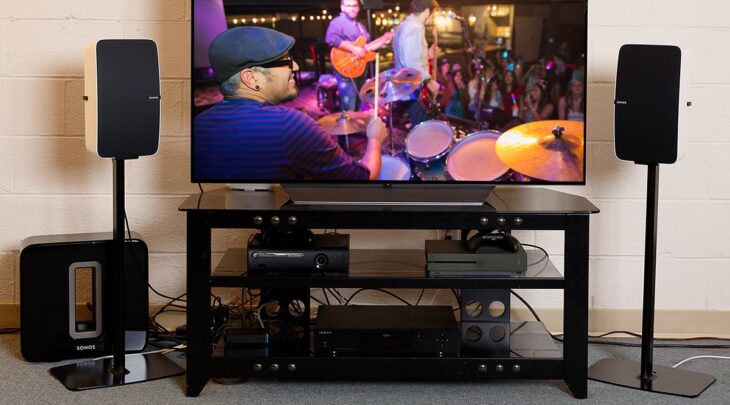
Sonos sells a lot of sets, and it can be rather overwhelming! I’ve narrowed the list down to six, prioritizing fully surround-sound systems and cheap-“ish” prices.
If you want the cheapest option, you’ll have to choose which is more important to you: subwoofer bass or surround sound.
If you want surround-sound, go with the “Circled in Sound” set from Bose – it’s cheaper than the soundbar/surround-speakers combo from Sonos. If you prefer a subwoofer, try out the Sonos Entertainment Set with Beam for roughly the same price point.
If you want a wider range of audio frequencies, then you’ll need an upgrade. Decide if you want a subwoofer, or top-notch soundbar ranging several frequencies. If you want a subwoofer, try the Immersive Set with Beam. If you want the soundbar, try Surround Set with Arc.
Lastly, if you want the crème-de-la crème, then you’ll want to decide on your budget and soundbar choice. If you can settle with a Beam, then the Premium Immersive Set with Beam will work great. If you prefer the Arc though, plan on forking out several more hundred dollars for the Premium Immersive Set with Arc.
With the specifics of the Bose vs Sonos debate out of the way, let’s cover the other, more general aspects of modern home theater systems.
What You Need to Make a Home Theater
Home theaters are exciting! There’s something special about immersing yourself completely in cinema, often with friends next to you. In fact, though it might seem trite, moviegoing has been a huge factor in social movements throughout the last 100 years.
But here’s the thing you need to know upfront: they can be a HUGE rabbit hole.
Rather than bombarding you with all the details and options, we’re going to keep things simple. Here are the absolute basics you need to know to get started.
Screens and Projectors
First, you need a screen and/or projector. Obviously, you need something to produce the images and something to put them on. While flat-screen TVs are the obvious choice, they aren’t the only ones.
By pairing special projectors with projector screens, you can get much bigger images. This is one of the reasons people go to movie theaters; the big screens really force you to get lost in the story.
As you begin the descent into the home theater rabbit hole, you’ll find that both products have lots of in-depth specs, such as screen ratio and color enhancement. They’re beyond the scope of this article, but interesting nonetheless!
Chairs and a Room
Second, you need comfy chairs and a quiet, dark room. Do whatever you want for the chairs. The room itself is quite important though, as we’ll see in later sections.
Simple enough!
Electronic Media Components
Next, you need “electronic media components.” These guys are like the “brains” of the entire system. They store, process, and transmit the information stored in the film.
The most important component is the “receiver,” which takes in all the information and sends it where it needs to go – the images go to the projector/screen, and audio goes to speakers.
Other media components include DVD players, digital media servers, and digital media hubs, among others (it’s a rabbit hole, remember!)
DVD players may be almost obsolete; but just like vinyl records and turntables, their analog technology produces a superior film experience. However, if you have an extensive digital film collection, you can store it all on a private server.
A ‘server’ is simply a digital storage space that users can access with outside devices. In fact, every website you visit is stored on a server computer somewhere in the world.
A digital media hub lets you access films from different sources, then routes them to the receiver. Nowadays, most media hubs are devices that connect directly to a streaming service. Examples include Amazon Firesticks and Roku televisions.
Despite all the extensive options though, here’s the cool thing: you may not know it, but you already have a receiver and media hub.
Whatever device you use to stream media is both your receiver AND hub; tablets, phones, laptops, TVs, you name it. Your streaming app is the hub, while your device’s audio and HDMI jacks make it a receiver.
But in the spirit of the rabbit hole, you can always improve your setup. After all, the whole point of building a home theater is to raise your standards. It’s a lot like an audiophile’s turntable setup, where you get to pick all the pieces that go into your custom design.
So, there you have it; to make a home theater you need a screen and/or projector, speakers, and media components.
But as a music website, we only care about the audio equipment! Media components are out of the scope of this article. Instead, we’ve mainly focused on speakers, and checked out Bose and Sonos at the same time!
How Home Theater Speakers Work
Just like guitar amplifiers, speakers come in various shapes, sizes, and kinds. Each specification serves a purpose, which we’ll look at now. Thankfully for beginners, it’s all pretty simple to understand!
How Many Speakers Should I Get?
If you’ve ever paid special attention to the sound in a movie theater, you might have noticed that it literally surrounds you.
For example, when you watch Star Wars, you can hear the spaceships fly over and past you. Or if you have the guts for it, you can hear D-Day bullets flying all around you in Saving Private Ryan.
How can you do this? It’s simple: they use more than one speaker!
The best home theater setups use at least five speakers. These setups are called “5.1” setups, which I’ll explain in a second.
Two are placed on the left and right sides of the screen. Two more are placed on the left and right … but this time, they’re BEHIND your seat (tricky, right?!)
These four speakers force you to be immersed in the audio. You can hear ambient noise, sound effects, music – what have you – to your left and right, and in front and behind you.
But if you’re counting, you’ll know we’re not done yet. Another speaker is placed directly in the center of the screen, and projects the film’s dialogue. This helps isolate it from everything else, making it pop out.
Lastly, we have the subwoofer, which produces the deepest sounds in a film. It’s the source of that ominous low growling you hear from the theater hallway. Of all speakers, the subwoofers are the most important for an immersive experience.
The 5 in the “5.1” label represents the surround sound speakers and central speaker. The .1 represents the subwoofer. You can also increase the number of speakers to a 7.1, or even 9.1 system!
Unfortunately, many systems at 5.1 or above are incredibly expensive. Bose’s go-to option is the 3.1 Home Theater System, which cuts the two rear speakers. Even this is around $2,500!
Sonos, on the other hand, is even more expensive! You have to buy each speaker separately, which lets you customize more. Their Sonos Arc (central soundbar) and Sonos Sub (subwoofer) speakers are standard fare.
You can choose between Sonos Era 100 and Sonos Era 300 speakers for the front speakers, depending on how much you want to spend.
But what if you can’t afford to drop $2500+ on speakers … which, let’s face it, is most of us … what are your other options?
Turns out there are two more!
Soundbars (and Why They’re Great!)
What if you could buy one piece of hardware that functioned as several speakers at the same time?
Enter,the soundbar!
Soundbars are a great home theater option for those on a budget or living in a small house. They are cheaper than buying multiple speakers, and take up far less space!
They look just like their name. Most are as long as your TV is wide, and narrow enough to sit on the ledge in front of it. More importantly, soundbars house at least three speakers inside of them.
All of them include the left and right speakers, with the central one in the, well … center! More expensive models can have more though, with each one serving a specific function.
Unfortunately, soundbars will not provide the same immersive experience as real surround-sound speakers. However, they often use psychoacoustic technology to mimic the effects of a surround-sound system the best they can (don’t worry, Norman Bates won’t stab you in the shower!)
For many of us, this will work perfectly fine. You will want to buy an additional subwoofer if you can, but it’s not necessary. Either way, it will still be cheaper than a full 5.1 system.
Last But Not Least: The Home Theater System!
So far, we’ve discussed two routes you can take to build a Bose or Sonos home theater system. First, you can go all out and build your own 5.1 speaker system. Second, you can buy a budget soundbar (with a subwoofer if you’d like).
There is one more option, which is the “home theater system.” This one is simple: everything comes as a complete set, like a kit!
Fortunately, many of these are cheaper 5.1 setups, albeit with lower quality. Others can come prepackaged with a soundbar plus extra speakers; it all depends on the specific product.
Either way, they can be a great budget option for home theater beginners. Sonos doesn’t sell any pre-packaged systems, which is a plus for Bose. I highly recommend their Acoustimass 10 Series IV Home Entertainment Speaker System.
Conclusion
As you see, home theater speaker setups can be very complicated. However, I hope this article helped give practical advice on Bose and Sonos products so you can be happy with the setup you choose.
In conclusion, I’ll restate the three methods you can take to get set up as soon as possible:
First, you can buy a soundbar. This is the cheapest and fastest option. While it won’t create a fully surround-sound system, a soundbar can create a convincing experience that is great for many folks. You might want to pair it with a subwoofer, though.
Second, you can upgrade an existing soundbar setup with surround speakers – or just buy all the speakers individually! In this case, you will want to decide how versatile your setup will need to be.
This is admittedly tricky. While Bose’s Bluetooth capabilities makes it easy to connect from any device, their surround speakers are useless without a soundbar.
Sonos speakers are harder to connect to; but once set up, they are more efficient to use. Conversely, their surround speakers can be used as general speakers.
Third, you can skip all the difficult thinking and jump straight to a prepackaged set. You will need to decide how authentic you want your surround-sound setup to be, and what your budget is.
Lastly, remember both companies’ philosophies. Sonos aims for wireless simplicity, through Wi-Fi specifically. Bose can be a bit more complicated, but often allows for more diverse usage.
There truly is something magical that happens when you experience cinema in a fully immersive theater. And when you own one, you can share it with anyone! Whatever you choose, enjoy the journey!

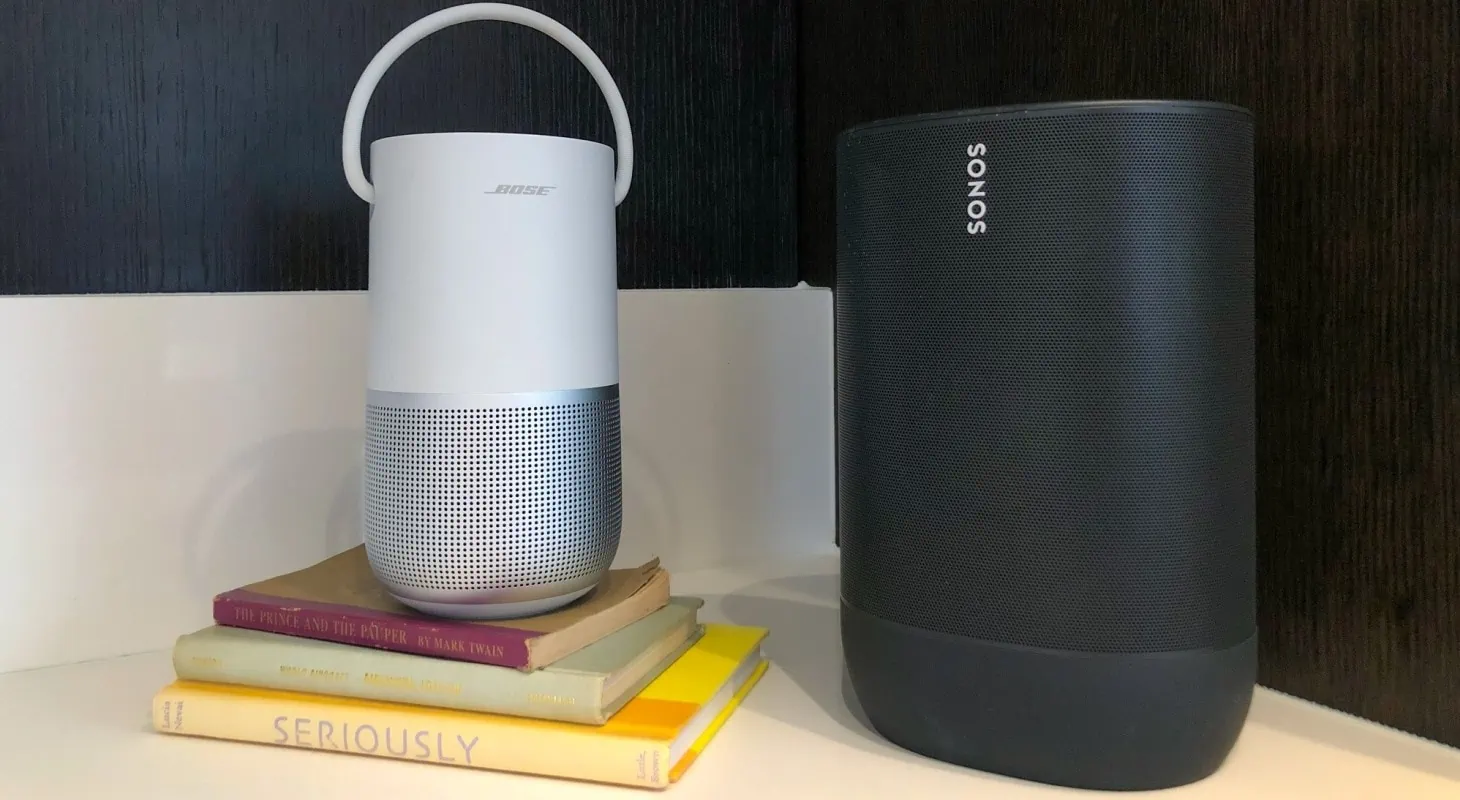
Thanks for the article. Very informative and well written. Which would you pick if you were also playing a lot of music on? Leaning towards the Bose seismic ultimate package. Love loud, clear, crisp music. Any advise?